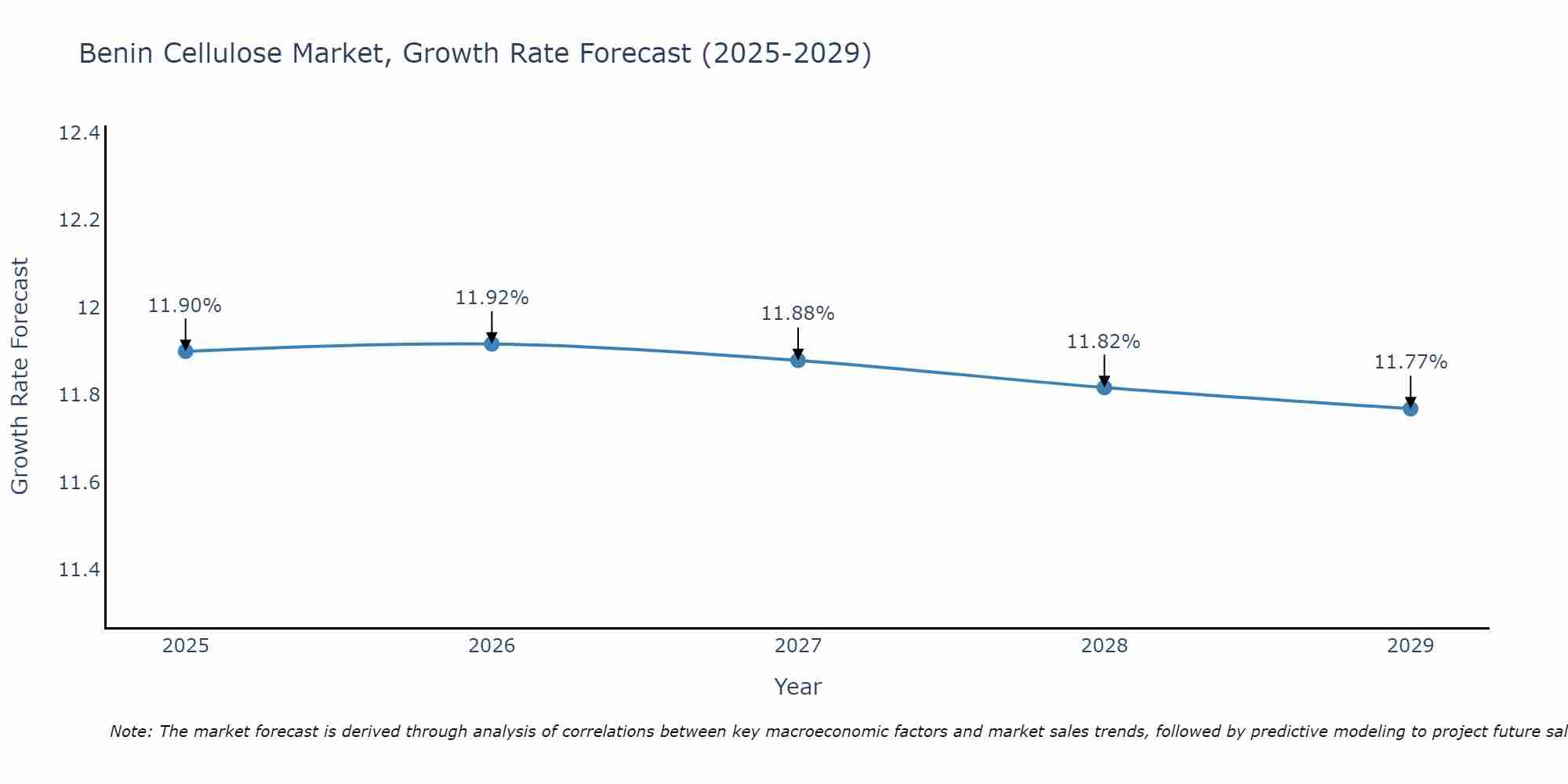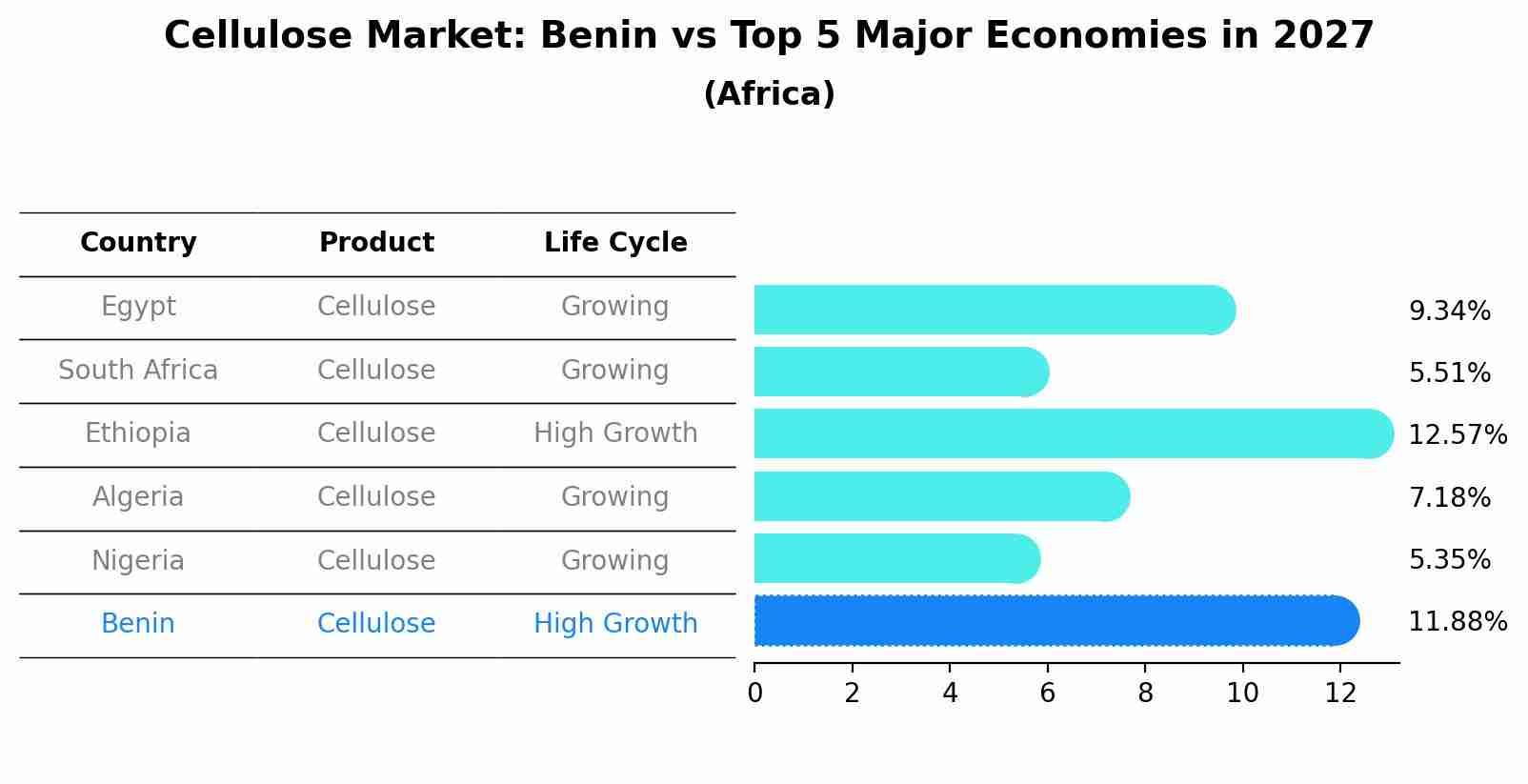Benin Cellulose Market (2025-2031) | Share, Trends, Companies, Revenue, Size, Industry, Outlook, Growth, Value, Forecast, Segmentation & Analysis
| Product Code: ETC4661921 | Publication Date: Nov 2023 | Updated Date: Sep 2025 | Product Type: Market Research Report | |
| Publisher: 6Wresearch | Author: Shubham Padhi | No. of Pages: 60 | No. of Figures: 30 | No. of Tables: 5 |
Benin Cellulose Market Size Growth Rate
The Benin Cellulose Market is projected to witness mixed growth rate patterns during 2025 to 2029. The growth rate begins at 11.90% in 2025, climbs to a high of 11.92% in 2026, and moderates to 11.77% by 2029.

Cellulose Market: Benin vs Top 5 Major Economies in 2027 (Africa)
The Cellulose market in Benin is projected to grow at a high growth rate of 11.88% by 2027, highlighting the country's increasing focus on advanced technologies within the Africa region, where Egypt holds the dominant position, followed closely by South Africa, Ethiopia, Algeria and Nigeria, shaping overall regional demand.

Benin Cellulose Market Overview
The cellulose market in Benin is developing, supported by its applications in paper, textiles, and bioplastics. Cellulose is a fundamental component in the production of numerous materials due to its renewable and biodegradable nature. Market growth is driven by increasing demand for sustainable materials, rising production of paper and textiles, and advancements in cellulose extraction and processing technologies.
Drivers of the market
The Benin Cellulose market is driven by the growing demand for sustainable and biodegradable materials in various industries. Cellulose, derived from natural sources such as wood and plants, is used in the production of paper, textiles, and biodegradable packaging. As consumers and industries increasingly prioritize eco-friendly solutions, the demand for cellulose as a renewable resource is rising. Additionally, advancements in cellulose processing and applications in pharmaceuticals and food industries further support market growth.
Challenges of the market
The cellulose market in Benin is constrained by several challenges including high import costs and limited local production capabilities. The extraction and processing of cellulose require specialized technology and infrastructure, which are not well-established in Benin. Additionally, the market faces competition from alternative fibers and fluctuations in global cellulose prices, which can affect supply and demand dynamics.
Government Policy of the market
The Benin government supports the cellulose market through policies that promote sustainable and innovative uses of cellulose. This includes regulations to ensure the quality and safety of cellulose products, incentives for local production, and support for research in cellulose applications. The government encourages industries to adopt eco-friendly practices and invest in technology that enhances the efficiency of cellulose processing.
Key Highlights of the Report:
- Benin Cellulose Market Outlook
- Market Size of Benin Cellulose Market, 2024
- Forecast of Benin Cellulose Market, 2031
- Historical Data and Forecast of Benin Cellulose Revenues & Volume for the Period 2021-2031
- Benin Cellulose Market Trend Evolution
- Benin Cellulose Market Drivers and Challenges
- Benin Cellulose Price Trends
- Benin Cellulose Porter`s Five Forces
- Benin Cellulose Industry Life Cycle
- Historical Data and Forecast of Benin Cellulose Market Revenues & Volume By Fiber Type for the Period 2021-2031
- Historical Data and Forecast of Benin Cellulose Market Revenues & Volume By Natural Cellulose Fibers for the Period 2021-2031
- Historical Data and Forecast of Benin Cellulose Market Revenues & Volume By Man-made Cellulose Fibers for the Period 2021-2031
- Historical Data and Forecast of Benin Cellulose Market Revenues & Volume By Applications for the Period 2021-2031
- Historical Data and Forecast of Benin Cellulose Market Revenues & Volume By Apparel for the Period 2021-2031
- Historical Data and Forecast of Benin Cellulose Market Revenues & Volume By Home Textile for the Period 2021-2031
- Historical Data and Forecast of Benin Cellulose Market Revenues & Volume By Industrial for the Period 2021-2031
- Historical Data and Forecast of Benin Cellulose Market Revenues & Volume By Others for the Period 2021-2031
- Benin Cellulose Import Export Trade Statistics
- Market Opportunity Assessment By Fiber Type
- Market Opportunity Assessment By Applications
- Benin Cellulose Top Companies Market Share
- Benin Cellulose Competitive Benchmarking By Technical and Operational Parameters
- Benin Cellulose Company Profiles
- Benin Cellulose Key Strategic Recommendations
Frequently Asked Questions About the Market Study (FAQs):
1 Executive Summary |
2 Introduction |
2.1 Key Highlights of the Report |
2.2 Report Description |
2.3 Market Scope & Segmentation |
2.4 Research Methodology |
2.5 Assumptions |
3 Benin Cellulose Market Overview |
3.1 Benin Country Macro Economic Indicators |
3.2 Benin Cellulose Market Revenues & Volume, 2021 & 2031F |
3.3 Benin Cellulose Market - Industry Life Cycle |
3.4 Benin Cellulose Market - Porter's Five Forces |
3.5 Benin Cellulose Market Revenues & Volume Share, By Fiber Type, 2021 & 2031F |
3.6 Benin Cellulose Market Revenues & Volume Share, By Applications, 2021 & 2031F |
4 Benin Cellulose Market Dynamics |
4.1 Impact Analysis |
4.2 Market Drivers |
4.2.1 Increasing demand for eco-friendly and sustainable products |
4.2.2 Growing awareness about the harmful effects of synthetic materials |
4.2.3 Government initiatives promoting the use of natural fibers in various industries |
4.3 Market Restraints |
4.3.1 High production costs associated with processing cellulose |
4.3.2 Limited availability of raw materials in Benin |
4.3.3 Lack of technological advancements in cellulose extraction and processing |
5 Benin Cellulose Market Trends |
6 Benin Cellulose Market Segmentations |
6.1 Benin Cellulose Market, By Fiber Type |
6.1.1 Overview and Analysis |
6.1.2 Benin Cellulose Market Revenues & Volume, By Natural Cellulose Fibers, 2021-2031F |
6.1.3 Benin Cellulose Market Revenues & Volume, By Man-made Cellulose Fibers, 2021-2031F |
6.2 Benin Cellulose Market, By Applications |
6.2.1 Overview and Analysis |
6.2.2 Benin Cellulose Market Revenues & Volume, By Apparel, 2021-2031F |
6.2.3 Benin Cellulose Market Revenues & Volume, By Home Textile, 2021-2031F |
6.2.4 Benin Cellulose Market Revenues & Volume, By Industrial, 2021-2031F |
6.2.5 Benin Cellulose Market Revenues & Volume, By Others, 2021-2031F |
7 Benin Cellulose Market Import-Export Trade Statistics |
7.1 Benin Cellulose Market Export to Major Countries |
7.2 Benin Cellulose Market Imports from Major Countries |
8 Benin Cellulose Market Key Performance Indicators |
8.1 Percentage of companies using cellulose-based products in their manufacturing processes |
8.2 Research and development investment in cellulose extraction and processing technologies |
8.3 Number of government policies supporting the use of natural fibers |
9 Benin Cellulose Market - Opportunity Assessment |
9.1 Benin Cellulose Market Opportunity Assessment, By Fiber Type, 2021 & 2031F |
9.2 Benin Cellulose Market Opportunity Assessment, By Applications, 2021 & 2031F |
10 Benin Cellulose Market - Competitive Landscape |
10.1 Benin Cellulose Market Revenue Share, By Companies, 2024 |
10.2 Benin Cellulose Market Competitive Benchmarking, By Operating and Technical Parameters |
11 Company Profiles |
12 Recommendations | 13 Disclaimer |
- Single User License$ 1,995
- Department License$ 2,400
- Site License$ 3,120
- Global License$ 3,795
Search
Thought Leadership and Analyst Meet
Our Clients
Related Reports
- Germany Breakfast Food Market (2026-2032) | Industry, Share, Growth, Size, Companies, Value, Analysis, Revenue, Trends, Forecast & Outlook
- Australia Briquette Market (2025-2031) | Growth, Size, Revenue, Forecast, Analysis, Trends, Value, Share, Industry & Companies
- Vietnam System Integrator Market (2025-2031) | Size, Companies, Analysis, Industry, Value, Forecast, Growth, Trends, Revenue & Share
- ASEAN and Thailand Brain Health Supplements Market (2025-2031) | Strategy, Consumer Insights, Analysis, Investment Trends, Opportunities, Growth, Size, Share, Industry, Revenue, Segments, Value, Segmentation, Supply, Forecast, Restraints, Outlook, Competition, Drivers, Trends, Demand, Pricing Analysis, Competitive, Strategic Insights, Companies, Challenges
- ASEAN Bearings Market (2025-2031) | Strategy, Consumer Insights, Analysis, Investment Trends, Opportunities, Growth, Size, Share, Industry, Revenue, Segments, Value, Segmentation, Supply, Forecast, Restraints, Outlook, Competition, Drivers, Trends, Demand, Pricing Analysis, Competitive, Strategic Insights, Companies, Challenges
- Europe Flooring Market (2025-2031) | Outlook, Share, Industry, Trends, Forecast, Companies, Revenue, Size, Analysis, Growth & Value
- Saudi Arabia Manlift Market (2025-2031) | Outlook, Size, Growth, Trends, Companies, Industry, Revenue, Value, Share, Forecast & Analysis
- Uganda Excavator, Crane, and Wheel Loaders Market (2025-2031) | Strategy, Consumer Insights, Analysis, Investment Trends, Opportunities, Growth, Size, Share, Industry, Revenue, Segments, Value, Segmentation, Supply, Forecast, Restraints, Outlook, Competition, Drivers, Trends, Demand, Pricing Analysis, Competitive, Strategic Insights, Companies, Challenges
- Rwanda Excavator, Crane, and Wheel Loaders Market (2025-2031) | Strategy, Consumer Insights, Analysis, Investment Trends, Opportunities, Growth, Size, Share, Industry, Revenue, Segments, Value, Segmentation, Supply, Forecast, Restraints, Outlook, Competition, Drivers, Trends, Demand, Pricing Analysis, Competitive, Strategic Insights, Companies, Challenges
- Kenya Excavator, Crane, and Wheel Loaders Market (2025-2031) | Strategy, Consumer Insights, Analysis, Investment Trends, Opportunities, Growth, Size, Share, Industry, Revenue, Segments, Value, Segmentation, Supply, Forecast, Restraints, Outlook, Competition, Drivers, Trends, Demand, Pricing Analysis, Competitive, Strategic Insights, Companies, Challenges
Industry Events and Analyst Meet
Whitepaper
- Middle East & Africa Commercial Security Market Click here to view more.
- Middle East & Africa Fire Safety Systems & Equipment Market Click here to view more.
- GCC Drone Market Click here to view more.
- Middle East Lighting Fixture Market Click here to view more.
- GCC Physical & Perimeter Security Market Click here to view more.
6WResearch In News
- Doha a strategic location for EV manufacturing hub: IPA Qatar
- Demand for luxury TVs surging in the GCC, says Samsung
- Empowering Growth: The Thriving Journey of Bangladesh’s Cable Industry
- Demand for luxury TVs surging in the GCC, says Samsung
- Video call with a traditional healer? Once unthinkable, it’s now common in South Africa
- Intelligent Buildings To Smooth GCC’s Path To Net Zero


















